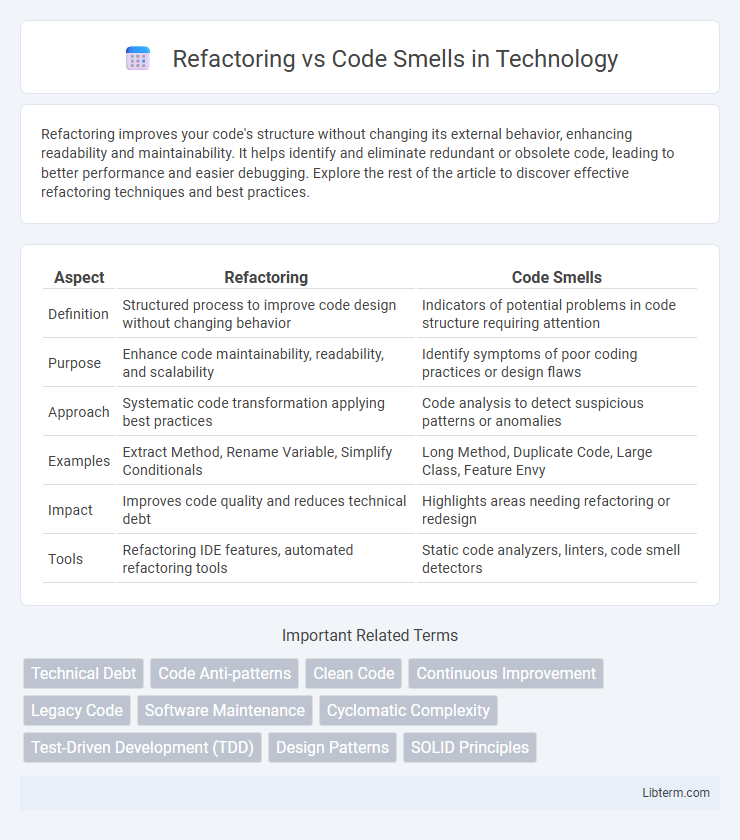Refactoring improves your code's structure without changing its external behavior, enhancing readability and maintainability. It helps identify and eliminate redundant or obsolete code, leading to better performance and easier debugging. Explore the rest of the article to discover effective refactoring techniques and best practices.
Table of Comparison
| Aspect | Refactoring | Code Smells |
|---|---|---|
| Definition | Structured process to improve code design without changing behavior | Indicators of potential problems in code structure requiring attention |
| Purpose | Enhance code maintainability, readability, and scalability | Identify symptoms of poor coding practices or design flaws |
| Approach | Systematic code transformation applying best practices | Code analysis to detect suspicious patterns or anomalies |
| Examples | Extract Method, Rename Variable, Simplify Conditionals | Long Method, Duplicate Code, Large Class, Feature Envy |
| Impact | Improves code quality and reduces technical debt | Highlights areas needing refactoring or redesign |
| Tools | Refactoring IDE features, automated refactoring tools | Static code analyzers, linters, code smell detectors |
Understanding Refactoring: A Brief Overview
Refactoring involves systematically improving the internal structure of existing code without changing its external behavior, enhancing readability, maintainability, and extensibility. Code smells are indicators or patterns in code that suggest potential refactoring opportunities, such as duplicated code, long methods, or large classes. Understanding refactoring helps developers address these code smells by applying techniques like method extraction, renaming, and modularization to produce cleaner, more efficient codebases.
What Are Code Smells?
Code smells are indicators of potential issues in the source code that suggest deeper problems affecting maintainability, readability, and scalability. Common code smells include duplicated code, large classes, long methods, and excessive coupling, which can lead to increased technical debt if not addressed. Identifying code smells is a crucial step before refactoring, as it helps developers target specific areas in need of improvement to enhance software quality.
Key Differences Between Refactoring and Code Smells
Refactoring involves systematically improving code structure to enhance readability, maintainability, and performance without changing its external behavior. Code smells are indicators or patterns in the code that hint at deeper problems, such as duplicated code, long methods, or excessive class coupling. The key difference is that refactoring is an intentional corrective process, while code smells are warning signs that signal the need for refactoring.
Common Types of Code Smells
Common types of code smells include Large Classes, Long Methods, Duplicate Code, and Feature Envy, all of which hinder code maintainability and readability. Refactoring targets these specific issues by breaking down large classes, extracting smaller methods, removing duplicated code, and redistributing responsibilities to appropriate classes. Addressing these smells improves software design, reduces technical debt, and facilitates easier future enhancements.
Benefits of Refactoring
Refactoring enhances code quality by systematically eliminating code smells such as duplicated code, long methods, and inconsistent naming conventions, which improves maintainability and readability. This process reduces technical debt, leading to fewer bugs and easier feature additions, thereby accelerating development cycles. Well-refactored code supports better performance optimization and clearer documentation, facilitating smoother collaboration among developers.
Identifying Code Smells in Your Codebase
Identifying code smells in your codebase requires scanning for patterns such as duplicated code, long methods, and large classes that indicate poor design or maintainability issues. Tools like SonarQube and ESLint can automate the detection of these smells by analyzing code metrics and anti-patterns. Early recognition of code smells allows targeted refactoring, improving code quality and reducing technical debt.
Strategies for Effective Refactoring
Effective refactoring strategies prioritize identifying code smells such as duplicated code, long methods, and large classes to enhance maintainability and readability. Applying systematic techniques like extracting methods, renaming variables for clarity, and simplifying conditional expressions reduces technical debt and improves code quality. Consistent integration of automated testing during refactoring ensures functionality remains intact while enabling safer, incremental improvements.
When to Refactor: Best Practices
Refactoring is essential when code smells such as duplicated code, large classes, or long methods hinder readability and maintainability. Best practices recommend scheduling refactoring during regular development cycles or immediately after identifying performance bottlenecks and technical debt to prevent codebase degradation. Using automated testing frameworks ensures changes maintain functionality, making refactoring safer and more efficient.
Tools for Detecting and Addressing Code Smells
Tools such as SonarQube, ESLint, and PMD effectively detect code smells by analyzing code quality metrics and highlighting anti-patterns like duplicated code, long methods, or large classes. Refactoring tools integrated in IDEs like IntelliJ IDEA and Visual Studio Code provide automated suggestions and transformations to address these smells, improving code maintainability and readability. Continuous integration pipelines often integrate these detection tools to ensure code smells are identified early and refactored systematically.
Impact of Refactoring on Code Quality
Refactoring significantly enhances code quality by systematically eliminating code smells such as duplicate code, long methods, and large classes, which often lead to maintainability issues and bugs. By restructuring code without changing its external behavior, refactoring improves readability, reduces complexity, and facilitates easier testing and debugging. This continuous improvement process not only boosts developer productivity but also extends software lifespan by making future modifications safer and faster.
Refactoring Infographic

 libterm.com
libterm.com